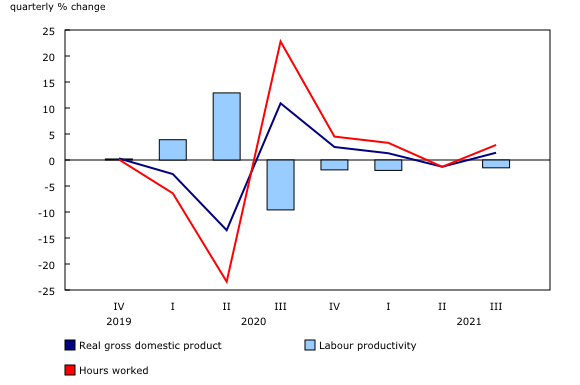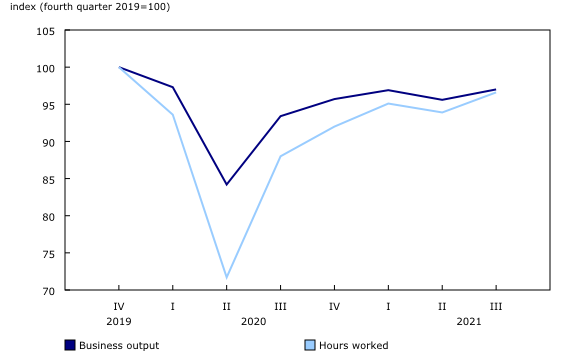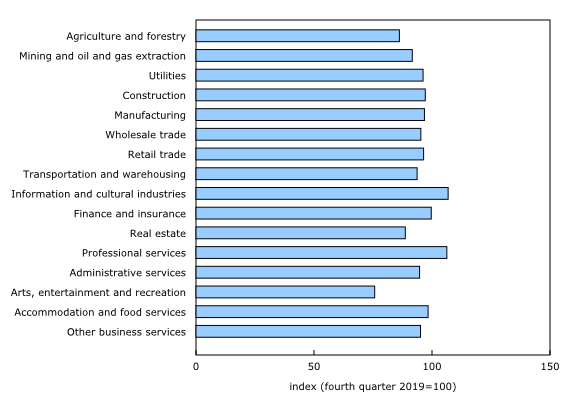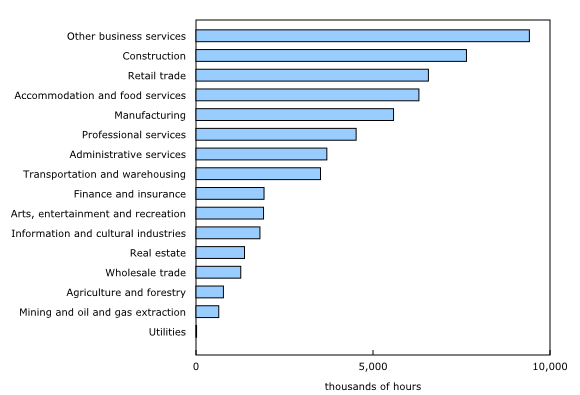Labour productivity, hourly compensation and unit labour cost, third quarter 2021
Archived Content
Information identified as archived is provided for reference, research or recordkeeping purposes. It is not subject to the Government of Canada Web Standards and has not been altered or updated since it was archived. Please "contact us" to request a format other than those available.
Released: 2021-12-03
Third quarter 2021
-1.5% 
(quarterly change)
Labour productivity down after zero growth in the second quarter
Labour productivity of Canadian businesses decreased by 1.5% in the third quarter, with hours worked rebounding more quickly than business output.
The decline in labour productivity in the third quarter follows zero growth in the previous quarter, where output and hours worked both fell at a similar pace. While the second quarter was marked largely by the third wave of the COVID-19 pandemic, the third quarter saw a rebound in output and hours worked caused by the reopening of a larger number of businesses, including those considered non-essential.
Since the start of the pandemic, labour productivity has typically fallen when restrictions have been loosened, with hours worked increasing more than output. In recent quarters, it has stabilized and continued to adjust in the third quarter. Compared with the fourth quarter of 2019—the last quarter before the start of the COVID-19 pandemic—productivity edged up 0.4%.
In the third quarter, health restrictions that affected recreation services in particular (e.g., hotels, restaurants, travel) were further relaxed, leading to a rebound in both business output and hours worked. However, growth in hours worked outpaced that of output, leading to a decrease in productivity in the third quarter.
Structural change is the main factor behind the overall decrease in productivity. In the third quarter, the increase in hours worked was much greater in industry sectors with lower value added and, therefore, lower productivity. In particular, industry sectors such as accommodation and food services, and arts, entertainment and recreation had strong growth in hours worked in the third quarter, increasing their relative weight. This reallocation of hours had a negative impact on the overall change in productivity.
Business output rebounds and approaches its pre-pandemic level
After a decline of 1.3% in the previous quarter, the real gross domestic product (GDP) of businesses rose 1.4% in the third quarter. With this rebound, the GDP of businesses approached its pre-pandemic level (-3.0% compared with the fourth quarter of 2019).
Overall, 10 of the 16 industry sectors increased their output, with the growth posted by service-producing businesses (+2.3%) more than offsetting the decline posted by goods-producing businesses (-0.9%).
In particular, the growth recorded by the accommodation and food services sector in the third quarter was stronger than the preceding quarter (+27.7%, after a 3.4% increase in the second quarter) because of the gradual reopening of bars and restaurants. The increase recorded in the arts, entertainment and recreation sector was also more pronounced (+22.8%, after a 3.1% growth in the second quarter) following the reopening of amusement parks, indoor and outdoor recreational facilities and casinos.
Hours worked also rebound, but more quickly
Hours worked in the business sector rose 2.9% in the third quarter, after declining 1.3% in the previous quarter.
With this rebound, hours worked are somewhat closer to their pre-pandemic level (-3.4% compared with the fourth quarter of 2019). This recovery is comparable to that seen in business output.
In the third quarter, hours worked rebounded in both service-producing businesses (up 3.8%, after decreasing by 1.1% in the previous quarter) and goods-producing businesses (up 0.9%, after decreasing by 1.7% in the previous quarter).
Overall, 12 of the 16 main industry sectors posted increases in hours worked. The accommodation and food services sector (+21.6%) and that of arts, entertainment and recreation (+14.8%) recorded the most significant increases, caused by the reopening of bars and restaurants, museums, amusement parks and casinos during the third quarter. In accommodation and food services, the gap between hours worked in the third quarter and the pre-pandemic level reduced significantly to 1.7% below their level in the fourth quarter of 2019. By comparison, hours worked in the second quarter of 2021 were 19.1% below their pre-pandemic level.
The gap from hours worked before COVID-19 still varied by industry sector in the third quarter, but differences between sectors narrowed.
The rebound in hours worked during the third quarter largely reflected that of employment (+3.6%), while hours worked per job decreased by 0.7%. The number of people with more than one job rose 7.5% in the third quarter, up from 2.1% growth in the previous quarter. Meanwhile, the number of people who were absent without pay was down 14.1% after being up 11.8% in the second quarter.
Losses in work hours because of COVID-19 are much lower in third quarter
When only workers who were active or on paid leave are taken into account, the net effect of the pandemic on hours worked in the business sector was a net loss of 56.9 million hours in the third quarter. This is a much smaller loss than was posted in the second quarter (-125.8 million hours).
Impacts of the COVID-19 pandemic on hours worked in the business sector, third quarter of 2021
Estimates of hours worked in the business sector are mainly based on data from the Labour Force Survey (LFS). It should be noted that for hours worked (used to measure productivity), both main and secondary jobs are considered—not only the main job as in the LFS. The main survey for the LFS for the reference period that includes the months of July, August and September does not capture losses of work hours outside the reference weeks. To account for those, as with the previous six quarters, the estimates of hours lost because of the pandemic were adjusted using a compilation of supplementary questions added to the LFS questionnaire in August, September and October 2021 for the respective reference months of July, August and September 2021. These adjustments are reflected in the data on hours worked and related measures (including labour productivity) for the third quarter of 2021.
At the industry level, loss of work hours because of COVID-19 declined across all industry sectors as health measures were relaxed during the quarter.
As in recent quarters, the loss of work hours posted in the third quarter is seen in other business services, retail trade, accommodation and food services, construction and manufacturing. Nearly 63% of all hours lost in the third quarter were in these five sectors, in which a higher proportion of jobs require working in close contact with others.
In the third quarter, other business services (-9.4 million hours) posted the largest loss of work hours among all industry sectors. In the second quarter, the loss of hours was almost twice as large in this sector (-17.3 million hours), since most of its activities, such as personal and laundry services, hair salons and beauty parlours, and repair and maintenance services, are considered non-essential.
Productivity declines in half of industry sectors
Both goods-producing and service-producing businesses contributed to the overall decrease in productivity in the third quarter. Productivity was down 1.8% in goods-producing businesses and 1.5% in service-producing businesses.
Overall, productivity fell in 8 of the 16 main industry sectors, and was unchanged in retail trade and professional services sectors.
In particular, arts, entertainment and recreation (+6.9%) and accommodation and food services (+5.0%) posted significant gains in productivity in the third quarter. However, these two industries are generally more labour intensive and have lower productivity than the industry average. For this reason, the large increase in hours worked in these two industries has a negative impact on the overall productivity growth of the business sector. This reallocation effect exceeds the positive contribution of productivity growth in each of the two industries during the quarter.
The largest productivity declines were posted in agriculture and forestry, construction, real estate, other business services and manufacturing.
In the United States, the labour productivity of businesses was down 1.2% in the third quarter, following two consecutive quarterly increases. A decline this sharp has not been seen since the fourth quarter of 1981. In the third quarter, real GDP growth for American businesses slowed to 0.3% after rising 2.0% in each of the last two quarters, while hours worked (+1.6%) rose at a faster pace than in the previous quarter (+1.3%).
Slower growth in unit labour costs than in the second quarter
Unit labour costs—that is, the cost of labour per unit of output—of Canadian businesses rose 1.9% in the third quarter, following a sharp 3.7% rise in the second quarter.
This slower rate of growth in unit labour costs reflects the significant slowdown in the growth of average compensation per hour worked (+0.4%), and productivity was down 1.5%. In the second quarter, hourly compensation rose sharply by 3.7%.
After four quarters of appreciation, the average value of the Canadian dollar relative to the US dollar was down 2.5% in the third quarter. With this depreciation, unit labour costs expressed in US dollars for Canadian businesses fell 0.7%, following a 6.9% increase in the second quarter.
By comparison, unit labour costs of American businesses rose 2.1% after edging up in the second quarter (+0.3%).
Sustainable development goals
On January 1, 2016, the world officially began implementing the 2030 Agenda for Sustainable Development—the United Nations' transformative plan of action that addresses urgent global challenges over the following 15 years. The plan is based on 17 specific sustainable development goals.
The release "Labour productivity, hourly compensation and unit labour cost" is an example of how Statistics Canada supports the reporting on the global sustainable development goals. This release will be used to help measure the following goal:

Note to readers
Volatile data starting in the first quarter of 2020
Data have been quite volatile from one quarter to the next since the first quarter of 2020, reflecting the impacts of the pandemic on economic activity and the labour market. Given the strong variations in the last quarters, the percentage changes from the pre-pandemic level—i.e., from the fourth quarter of 2019—can better reflect the changes in productivity and related measures than percentage changes from quarter to quarter. However, the quarterly data in Table 1 of this release are presented only in the usual format: the percentage change from the same quarter in the previous year and the change from the previous quarter.
Revisions
With this release on labour productivity and related measures, data were revised back to the first quarter of 2017 at the aggregate and industry levels. These revisions are consistent with those incorporated in the release on quarterly gross domestic product (GDP) by income and expenditure and the release on monthly GDP by industry, released on November 30, 2021.
Productivity measures
The term productivity in this release refers to labour productivity. For the purposes of this analysis, labour productivity and related variables cover the business sector only.
Labour productivity is a measure of real GDP per hour worked.
Unit labour cost is defined as the cost of workers' wages and benefits per unit of real GDP.
The approach to measuring real output in the business sector differs from the one that is used in the estimates by industry. For the business sector, output is measured using the expenditure-based GDP approach at market prices. This approach is similar to that used for the quarterly measures of productivity in the United States. However, output by industry is based on the value added at basic prices.
All the growth rates reported in this release are rounded to one decimal place. They are calculated with index numbers rounded to three decimal places, which are now available in data tables.
All necessary basic variables for productivity analyses (such as hours worked, employment, output and compensation) are seasonally adjusted. For information on seasonal adjustment, see Seasonally adjusted data – Frequently asked questions.
Next release
Labour productivity, hourly compensation and unit labour cost data for the fourth quarter of 2021 will be released on March 4, 2022.
Products
The Economic Accounts Statistics Portal, accessible from the Subjects module of our website, features an up-to-date portrait of national and provincial economies and their structures.
The Latest Developments in the Canadian Economic Accounts (13-605-X) is available.
The User Guide: Canadian System of Macroeconomic Accounts (13-606-G) is available.
The Methodological Guide: Canadian System of Macroeconomic Accounts (13-607-X) is available.
Contact information
For more information, or to enquire about the concepts, methods or data quality of this release, contact us (toll-free 1-800-263-1136; 514-283-8300; infostats@statcan.gc.ca) or Media Relations (statcan.mediahotline-ligneinfomedias.statcan@statcan.gc.ca).
- Date modified:





